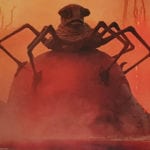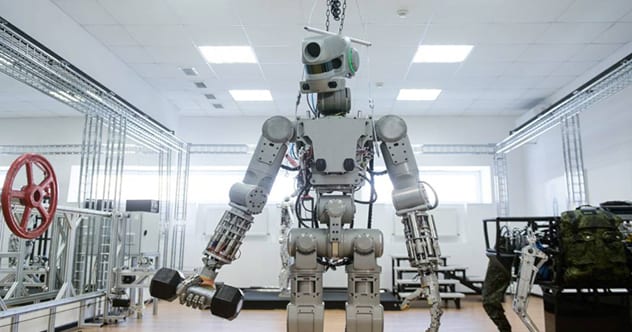10A Moon Lands On Chewbacca
To its credit, one thing the extended universe stories did not do lightly was kill characters from the original trilogy. This all changed when it came to the novel Vector Prime. Vector Prime features original characters such as Han and Chewbacca alongside extended universe characters such as Han and Leia’s children fighting extra-galactic invaders known as the Yuuzhan Vong. One of those children, Anakin Solo, nearly dies when he’s blown away from the Millennium Falcon shortly before the destruction of a planet. The source of both the wind and the destruction is unique: The Yuuzhan Vong used a device to bring the planet’s moon down on top of it, destroying all life. Chewbacca saves Anakin by bringing him to the Falcon but then gets swept away himself. Anakin, now piloting the Falcon, decides rescuing Chewie would get them all killed and flies away—leaving Han Solo distraught as he watches his Wookie partner killed by a moon.
9Luke’s Ghost Girlfriend
Though Luke Skywalker’s romances in the original trilogy began and ended with his sister, he has had several romantic partners in the extended universe. The most famous is Mara Jade—a former agent of the Emperor who marries Luke. However, the strangest of those partners would be his ghostly girlfriend. Luke proves that Jedi really are above worldly things when he falls in love with Callista Ming, an old-school Jedi who survived Darth Vader’s purge by placing her mind inside a computer. While it looks like Luke will be condemned to living out his own version of Spike Jonze’s Her, a unique and morally questionable opportunity arises when one of Luke’s students wants to die to be with her lover. She donates her body to Luke, who is fine with both assisted suicide and having his old girlfriend running around in the younger body of one of his own students. Something happens during transfer, though, and Callista can’t use the Force afterward, causing them to split up. Or, alternatively, they realize how creepy things have gotten.
8Clones Ravaging The Galaxy
For years, all fans had to go on regarding “clones” was Leia’s offhand mention in A New Hope of Obi-Wan serving alongside her father in “the Clone Wars.” The prequel trilogy would clarify that this was a galactic war in which the clones fought. Before that, though, many assumed something very different: that this was a war in which the galaxy fought out-of-control clones. In 1986, this assumption was almost given physical form when manufacturer Kenner planned to release toys based on their own continuation of the Star Wars story. One of the characters was Atha Prime, the architect of the Clone Wars in Kenner’s story, who would be accompanied by a new clone army. The toy idea was eventually scrapped. Perhaps the most famous explication of the “clones vs. the galaxy” plotline came from Timothy Zahn. The veteran writer kicked off the official Star Wars extended universe with his trilogy of books featuring our heroes battling Imperial Grand Admiral Thrawn and insane Jedi clone Joruus C’baoth. Zahn not only supported the evil clones bit but gave an explanation for it. Grand Admiral Thrawn discovers that clones grown too quickly go insane due to a resonance created in the Force by having two (or more) of the exact same minds out there. Thrawn manages an alien workaround by surrounding his own cloning cylinders with Force-canceling Ysilimiri, quickly raising a new clone army that many fear will herald a second round of Clone Wars.
7Palpatine’s Countless Clones
Speaking of clones, one of the more comic book–like aspects of the extended universe came from (fittingly) the Dark Empire comics. In a universe where characters can transfer their minds via the Force to everything from humans to computers, then what would someone with both the resources and Force prowess of Emperor Palpatine do? According to these comics, he had a cadre of backup clone bodies and was able to quickly transfer his mind into new ones at will. This is handy because, according to these comics, the whole “dark side will consume you” thing was pretty literal, and the dark energies Palpatine used would destroy his body in relatively short order. When Luke encounters a wizened Palpatine, he makes the ethically dubious choice to kill all of the clone bodies to prevent Palpatine from making the transfer. This fails, leaving both Luke and the galaxy to defend against an Emperor stronger than they had ever known.
6Han Solo Kidnaps Princess Leia
Historically, Star Wars has been pretty awkward regarding romance. The prequel trilogy, of course, is notorious for the wooden dialogue throughout, with a definite lowlight Anakin trying to make complaints about sand seductive. And while Empire Strikes Back was executed with humor and wit, Return of the Jedi’s conclusion reduced Han and Leia’s romance to a teenage rom-com, with Han concerned with whether Leia would choose him or Luke. The same kind of choice is at the heart of The Courtship of Princess Leia, which starts with a realistic scenario. A wealthy prince is willing to offer his resources to Leia and the New Republic if she will marry him. For practical Leia, this is tempting—give her fighters a huge boost, and all she has to do is marry the charming, handsome, and filthy-rich prince. Before she can decide, Han literally kidnaps her to the planet of Dathomir, swearing he will make her love him in seven days’ time. While the rest of the novel is taken up by things such as Force witches, the most remarkable thing about it remains the specter of woman-kidnapping, ultimatum-giving, and vaguely date-rapey Han Solo.
5The Galaxy’s Street-Fighting Tournament
For better or worse, Star Wars has often had a chameleon-like quality when it comes to video games. LucasArts gauges what’s popular, creates its own version, and see what sticks. Popular games like Jedi Outcast came from the original choice to make the first-person shooter Dark Forces—their own version of Doom. The venerable X-Wing and Tie Fighter computer games were Star Wars’s own take on the popular Wing Commander games. However, this form of flattery via imitation occasionally backfires. It did so spectacularly in the case of the PlayStation game Star Wars: Master of Teras Kasi. The mid-’90s had a mania for fighting games, with titles like Street Fighter II and Mortal Kombat gaining worldwide attention, while 3-D fighters like Tekken helped push the technical envelope. Teras Kasi is a fighting game that involves Vader and his assassins fighting Luke, Han, and the rest of our heroes. The game was faulted for its sluggish combat and baffling decision to allow hand-to-hand combat (Luke is not exactly known for his pugilistic prowess). And from a plot standpoint, having everyone engage in non-lethal timed rounds does not seem to be the most efficient way for Lord Vader to kill his enemies.
4The Kessel Run Justification
“Is it a fast-ship?” asks the incredulous Obi-Wan Kenobi. Han reassures him about the Millennium Falcon: “It’s the ship that made the Kessel Run in less than 12 parsecs.” Cue decades of nerds eager to point out that parsecs measure distance, not time. While young George Lucas obviously meant the unit to represent time, many have tried to justify the error. Writer A.C. Crispin made it official in her Han Solo trilogy of books. In it, she posits that the Kessel Run brings smugglers very close to a cluster of black holes known as “The Maw.” During a particularly desperate run, Han skirts very close to the black holes and lives to tell the tale, managing to make the run in 20 fewer light-years than the average smuggler. In typical Star Wars fashion, though, this created a new problem that could be easily guessed by the average Interstellar fan. Due to the time dilation created by that parsec-canceling run near the black holes, Han would have to be older than Obi-Wan Kenobi. Forty years would have gone by since he started making the Kessel Run as a young man.
3Trillions Killed By Infidel-Haters
Over time, the expanded universe of Star Wars stories faced the same problem many had always known it would face: It ran out of stories. At least, it ran out of stories in the traditional mold—rebels vs. Empire. So, for better or worse, the collected Star Wars scribes created a new story with a new galactic menace known as the Yuuzhan Vong. In a galaxy now filled with Luke’s trained Jedi, these aliens’ ability to avoid Force detection made them especially deadly. However, the legacy of these stories left two decidedly weird tastes in reader’s mouths. One was the sheer death toll of these invaders—while the cinematic Star Wars had always emphasized last-minute saves and the minimization of death and destruction (Alderaan notwithstanding), these books featured the Vong wiping out over 300 trillion intelligent beings. The other uncomfortable aspect for some readers was the possibility that the Vong were symbolic representations of Al-Qaeda. Specifically, the aliens held a strict code of religious honor and considered the creatures they killed to be “infidels.” Additionally, plotlines featuring hijacked cargo ships crashing into Coruscant’s shields struck some as a poor-taste homage to the events of September 11, 2001. Combine that with the occasional suicidal attacks launched by these aliens and the galaxy “far, far away” felt uncomfortably like the wartime of the early 21st century.
2Han Solo’s Space Hitler Son
One thing becomes abundantly clear when reading the extended universe of Star Wars: Some plots are just doomed to repeat themselves. A kinder way to say this is that Star Wars deliberately draws upon universal archetypes, making the story familiar even to those who have never seen it. The tale of a young man receiving a magical sword and being trained by an old wizard to storm castles and save princesses is nothing more than King Arthur in space. A rather shameless repeating detail in these stories is the path of the dark side being littered with good intentions. Jacen Solo, another son of Han and Leia, grows into a powerful Jedi whose experience with war and being tortured has him flirt with the dark side. Perhaps that flirtation would have ended after his escape from torture, but when he tries to get visions of the future, he sees himself killing Luke Skywalker and plunging the galaxy into war. So, to keep this from happening, he takes up the ways of the Sith and—wait for it—plunges the galaxy into war anyway. While he never kills Luke, he does manage to kill Luke’s wife, Mara Jade, and torture Luke’s son Ben Skywalker. Eventually, he calls himself Darth Caedus, but before you can ask yourself how many times you’ve seen this before, he is killed by his twin sister, Jaina.
1Luke Turns To The Dark Side
Yoda, of course, is famous for his garbled phrases and circuitous, fortune cookie messages about the life of a Jedi. However, there’s one thing that he is quite clear on: “Once you start down the dark path, forever will it dominate your destiny. Consume you it will, as it did Obi-Wan’s apprentice.” If Yoda’s force ghost wanted to make a meme of this, it would probably just be crispy Anakin Skywalker’s body and the caption: “Dark Side: Not even once.” The Dark Horse Star Wars comics wasted no time in walking back this Yoda wisdom, though. In the Dark Empire comics—the same ones that introduced the aforementioned clone Emperor—Luke succumbs to the dark side and becomes the Emperor’s apprentice. With all of the subtlety of an after-school special, Leia redeems Luke and turns the Emperor’s anger against him. That anger, in the form of a galaxy-threatening Force storm, literally consumes the Emperor. The redemptive ending aims to bring about the same warm fuzzies readers first got watching the celebratory Ewok campfire. But all later books and comics support Luke emerging from the dark side unfazed, which seems at odds with Yoda’s advice. Of course, like Obi-Wan says, Yoda’s words might have been true “from a certain point of view.” Help @PocketEpiphany . . . you’re his only hope!
























